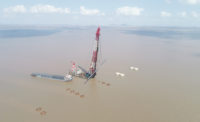
Engineering errors and other causes lead to an alarming number of failed industrial megaprojects, but the finger should be pointed at the project owner, not the EPC contractor. That's the conclusion of an ongoing, multiyear study conducted by Independent Project Analysis Inc., with the participation of nearly 100 of the largest owners of global industrial projects.
"Of all the things we need to do, the most important is to stop the large project blow-outs," says Ed Merrow, IPA president. "Our industry, overall, has the misfortune that, the bigger it is, the harder and more often it tends to fall."
IPA presented the survey results to hundreds of owners and contractor representatives at the annual Construction Users Roundtable national conference, held on Feb. 9-11 in Chandler, Ariz.
The study examined over 3,700 projects and found a strong correlation between failure rate and size. Around 37% of projects under $750 million fail. But megaprojects over that amount tend to fail nearly two-thirds of the time.
In the study, a project failed if it met at least one of four criteria: Its costs grew by 25% or more; the schedule slipped at least 25% (one year, on average, for mega- projects); the project overspent compared to the industry average; or there were severe and continuing operational problems lasting more than two years after startup.
Merrow says projects derail long before contractors get on board. Owners may not perform sufficient front-end work on basic project parameters, such as scope and design. Or they don't properly shape the business aspects of the project, such as justifying the project, identifying stakeholders and properly governing joint ventures.
Errors in basic data, including engineering design and constructibility, lead to the failure of about 30% of mega- projects, Merrow says. "We are facing a profound crisis in engineering that is making it very difficult to do these complex, engineering-intensive projects successfully." The engineering error rate has doubled since 2006, according to the study; Merrow describes some of them as "Chemical Engineering 101-type errors."
One IPA study participant says his firm avoids many pitfalls by developing a project plan years before field construction begins, which helps to ensure the job is cost-effective and not driven by schedule.
Even after the contractor joins the project, owners can still stumble. In a separate presentation at the conference, John Pemberton, vice president of Intel's technology and manufacturing group, said, "We, as owners, are a big chunk of the problem. We write the contracts, we set up how the game is going to get played, and we often set up adversarial relationships with many of the people who are trying to do good work on our behalf."
Pemberton says it's up to owners to step up and drive change. "If we want a different result, we have to play a different game," he adds.






Post a comment to this article
Report Abusive Comment